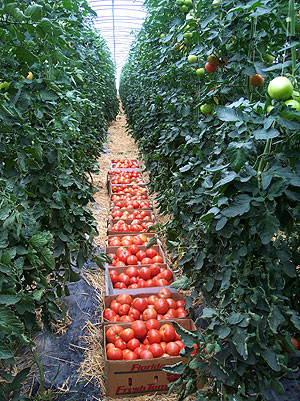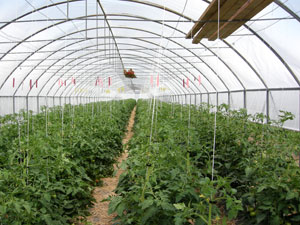
New ‘Best Management Practices’ factsheet:
Cherry Tomatoes – Pruning and Training
Structures and trellising
Timing
Bed preparation
Fertilization
Irrigation
Varieties
Pests and Diseases
Tomatoes are the crop most commonly grown in high tunnels in New York, and rank among the highest in economic returns.
Compared with field-grown tomatoes, high-tunnel tomatoes have several advantages:
- Earlier harvests in summer.
- Later harvests in fall.
- Better fruit quality.
- Less foliar disease.
Structures and trellising
One of the first decisions you need to make is whether you will grow determinate or indeterminate varieties. This will affect which type of high tunnel and trellising system you use.
Determinate varieties are lower-growing than indeterminate varieties. They reach a certain height and then stop growing, and tend to produce their harvest in a short window. Growers usually trellis them horizontally using the Florida-weave technique. Determinate varieties are the industry standard for field production in the Northeast, and many of them are early-yielding.

Indeterminate varieties will keep growing as long as the plants remain healthy and aren’t killed by frost. Varieties developed for greenhouse production and most heirloom tomato varieties are indeterminate. When grown in high tunnels, indeterminate varieties are trained vertically to a single leader by pruning off lateral growth – the secondary shoots known as suckers.
Growing indeterminate varieties requires an overhead bracing system to suspend the lines that can support the weight of the plants.
Gothic and hoophouses with straight sidewalls usually work best. Hoophouses without straight sidewalls can be used to grow indeterminate varieties in the center, with shorter crops toward the edges.
The advantage of growing indeterminate varieties on a trellis system is that you get a sustained yield over a longer period of time compared with determinate varieties. (You can spread out harvest with determinate varieties by planting several varieties with different days to maturity and/or staggering planting dates.) But trellising indeterminate varieties requires more labor than growing determinate varieties.
See Structures section of this website for more information.
See also:
Timing
Most growers transplant tomatoes into tunnels nearly 1 month ahead of field tomatoes. For most of central New York, late-April to early-May would be appropriate, with adjustments for warmer conditions downstate and colder conditions in the north, at higher elevations and in other cold pockets.
To reduce risk of plant-killing frosts inside the tunnel, it’s good to have a back up heat source.
Bed preparation
Most growers use black plastic mulch to warm soil and smother weeds, with drip irrigation under the plastic to maintain even soil moisture.
Soil must be tilled and loose before laying plastic. Small tractors or horses can draw tillage equipment in most tunnels, or you can use a hand operated rotary-tine tiller.
Commercial plastic mulch layers require a tractor that is too large for hoophouse and gothic structures. So in most cases, you’ll need to lay the plastic by hand — not too hard of a job with two or three people. Multi-bay high tunnels can accommodate field equipment to lay plastic and drip tape.
See also:
Fertilization
Test soil in fall to determine fertilizer and lime requirements for crops the following summer. (See Cornell Nutrient Analysis Laboratory for more information on soil testing.)
Soil preparation is a good time to incorporate any needed fertilizers and lime to get them distributed through the root zone. If you’re an organic grower, preplant application is especially important, as it might be difficult to find OMRI-approved fertilizers that can be applied through drip irrigation lines. See this CVP article on Nitrogen Fertility Options for Organic High Tunnels.
The big advantage of using drip tape is that you can inject fertilizer into the irrigation water periodically to maintain adequate nutrient levels in the plants. You can use foliar tissue analysis to monitor nutrient levels and adjust how much fertilizer you apply through the irrigation system. An injector is helpful for diluting soluble fertilizers.
Compared with field-grown tomatoes, tomatoes grown in high tunnels grow faster and yield more, so they also have higher nutrient requirements.
Magnesium is the most common deficiency seen in high-tunnel tomatoes, but is tolerable at low levels. Manganese deficiency is also common. Both can be identified and corrected before yield loss occurs.
Irrigation
Reliable, abundant water is important for high tunnel tomato production. A deep well or pond is a must. Some growers report using a gallon per plant per day during the peak of the season.
Unlike field production, any problems in the irrigation water will become concentrated inside the high tunnel as there is no leaching of the soil profile.
Water pH, alkalinity, nitrates and pathogen presence should be tested. Some water may be alkaline and require acidification.
Varieties
New York farmers have had success with the following varieties, but there are many more that will also do well.
Determinate:
- ‘Mtn. Spring’
- ‘Mtn. Fresh’
- ‘Florida 97’
Indeterminate:
- ‘Geronimo’
- ‘Trust’
- ‘Boa’
Heirloom:
- ‘Cherokee Purple’
- ‘Amish Paste’
- ‘Prudens Purple’
See also:
- Tomatoes for High Tunnels
- Grafting of Tomatoes for Soil-based Production in Protected Culture
- Determinate Tomato Variety Trial in a New York High Tunnel, 2011
Pests and diseases
One of the greatest benefits to growing high tunnels is improved foliar health of the plants compared to the field. This technique is popular with organic growers because diseases such as early blight and bacterial spot are often eliminated with no fungicide sprays.
However the tunnel environment can favor a few problems that are uncommon in field conditions in New York, primarily:
- Two-spotted spider mites
- Thrips
- Spotted Wing Drosophila (SWD) in Tomatoes
- Botrytis (Gray mold)
- Leaf Mold in High Tunnel Tomatoes
- Leaf mold
More pest and disease information:
- Cornell Integrated Crop and Pest Management Guidelines for Commercial Vegetable Production
- In High Tunnels, Diseases Are What You Make Them – From Tom Zitter, Department of Plant Pathology and Plant Microbe-Biology, Cornell University.
- NYSIPM program tomato pest and disease factsheets
- Tomato disease factsheets – From Cornell University’s Vegetable MD Online website.
- Elements of IPM for Greenhouse Tomatoes in NY State


